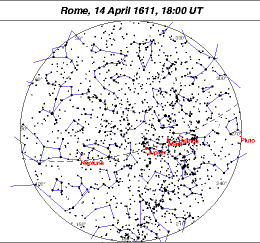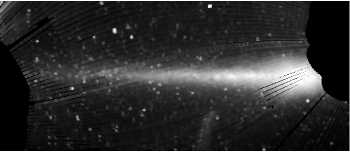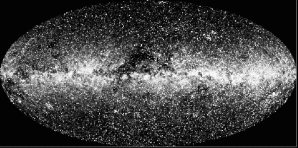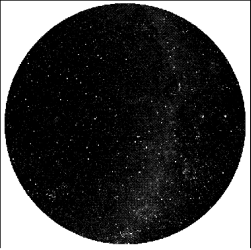
On the night of April 14, 1611, Galileo first demonstrated his telescope to others in Rome. In order to show how his instrument opened up the sky, I have endeavored to show how the sky appeared to the naked eye and how many more objects one could see with the telescope. Owen Gingrich of Harvard has estimated that Galileo's telescope could see objects as faint as eighth magnitude, and the standard unaided visual limit is sixth magnitude, so I wished to show the entire sky down to those limiting magnitudes.
| In the late 1980's, I wrote a program, now called SKYPIC, to create images from scanned data for the Spacelab 2 Infrared Telescope mission which flew on the Space Shuttle in 1985. An image created from that data has been published in the Astrophysical Journal Supplement (Kent et al. 1992). |

|
| To test that program, I used star catalogs as input, and as newer and larger catalogs came along, I added the capability of reading them. Along the way, the Hubble Space Telescope Guide Star Catalog of 18 million sources was added, and quite beautiful images of the entire sky were created (Mink 1994). The advantage of using such a large catalog is that there are so many faint stars in the Milky Way that their brightness adds up enough to show where our galaxy is on the sky. |

|
Armed with an image creation program and a variety of community-developed astrometry software, primarily from Pat Wallace's Starlink package and Elwood Downey's Xephem program, I added more features to my SKYPIC program. An altitude-azimuth projection enables me to show the sky as it apears from an arbitrary point on the Earth, and additional computational subroutines allow me to compute coordinates further back in time than the previous limit of 1950.
|
The final images are of the entire visible sky, centered at an azimuth of
180 degrees (south), with a pixel size of 20 arcminutes. They are
effectively half-sky snapshots taken in Rome on the night of April 14, 1611 at
7:00 pm,
10:00 pm, and
1:00 am,
showing what Galileo would have shown his colleagues.
Note the Milky Way background in the picture on the right, which shows
the sky to 8th magnitude at 7:00 pm.
The Harvard Gazette wrote an article about this project. For more about things Galileo did with his telescope, check out Ron Baalke's article about the discovery of Jupiter's Galilean satellites. ReferencesKent, S.M., Mink, D., Fazio, G., Koch, D., Melnick, G., Tardiff, A., and Maxson, C. 1992. ApJ Supp. 78R, p. 403-408. |

Click on this image to see what was visible without a telescope. |